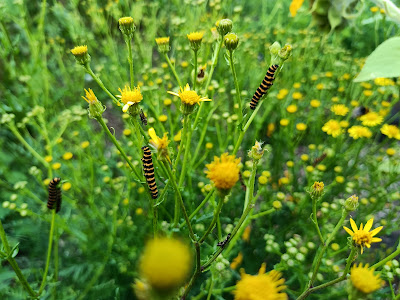Ragwort and the Cinnabar Moth
The title of this post sounds like a children's fairytale. Entirely unintended. I guess, in a way though, it is rather fitting because although ragwort (Senecio jacobaea) with it's delightful, and prolific, yellow flowers has many benefits, it also possessed what some consider a dark side. We have all the ingredients of a Grimm's fairytale me thinks, hahah!
Ragwort, although native to the UK, is classified by the government as an injurious weed. Why, you might ask, is it so vilified? It's because the plant contains toxins, called pyrrolizidine alkaloids, that cause liver damage and even death to grazing animals such as horses and cattle. My neighbour remembers back in the day the government advising the public to destroy any ragwort plants they encountered. Even now, DEFRA publishes a Code of Practice on How to Prevent the Spread of Ragwort.
However, many environmental conservation groups, such as Buglife, rail against this advice. This is because ragwort is such a crucial nectar source for so many pollinator species. I don't need to read the scientific literature to confirm the legitimately of this claim. All I need to do is observe the flowers in my own garden. Just look.
Hover flies, honey bees, bumble bees, visit constantly when the sun shines. This study, published in 2022, found that ragwort and the other nectar producing flowers DEFRA badges as 'injurious weeds' are visited by pollinator species twice as often as the flowers DEFRA recommends planting for pollinators... What an upsidedown world we live in... Sigh...
So where do cinnabar moths (Tyria jacobaeae) come into this story? Well, not only is ragwort an important nectar species, for the caterpillar of the cinnabar moth, ragwort is for all intents and purposes their sole food source. I'm pleased to say, these little beauties are festooning some of the ragworts in my garden right now.
They are so bold just perched up there on the flower tips, but predators give them a wide berth. As their black and orange stripes give away, eating the ragwort toxins makes the caterpillars themselves toxic.
Here is an interesting story about this weed/herbivore relationship. With no natural predators, ragwort became an invasive species in parts of the USA. It began covering swathes of land in the Northern Rocky Mountains. Attempting to solve this problem, in the 1990s, the state of Oregon trialed introducing cinnabar moths to act as a biological control for the invading ragwort. Amazingly, the trial was a resounding success. By 2002, the cinnabar moth and ragwort populations had reached equilibrium with each other resulting in the 'almost total disappearance of flowering tansy ragwort plants since 2002'.
Wow, that's a result!





Comments
Post a Comment
Please feel free to comment. Thank you.